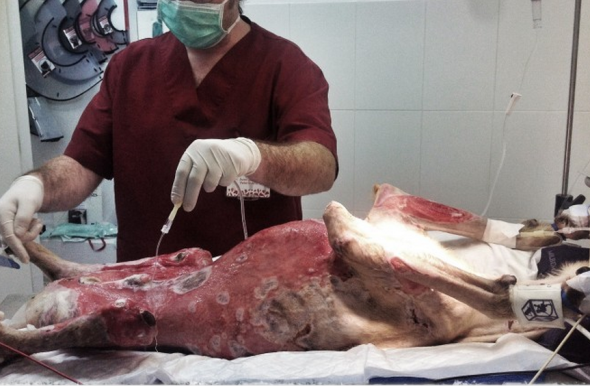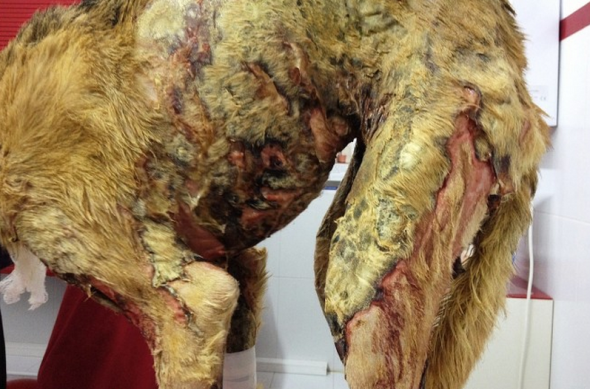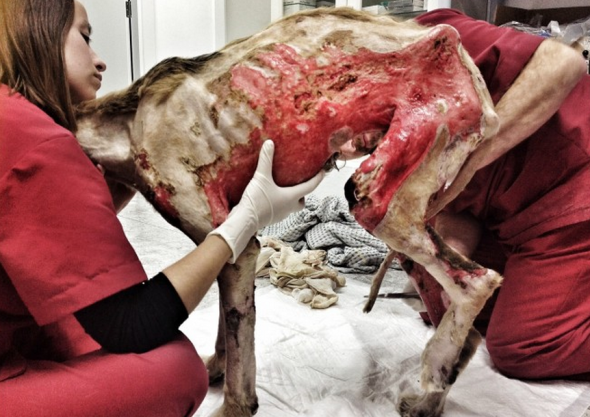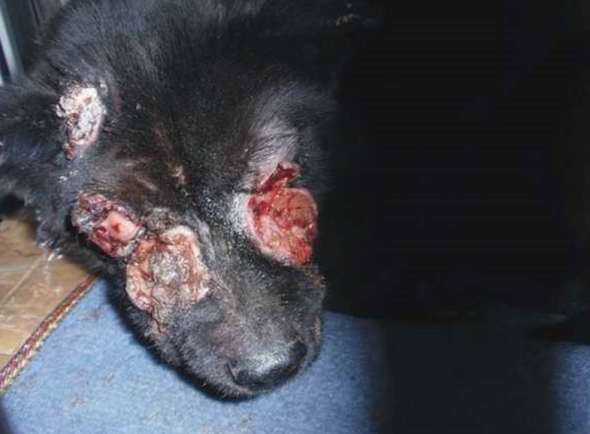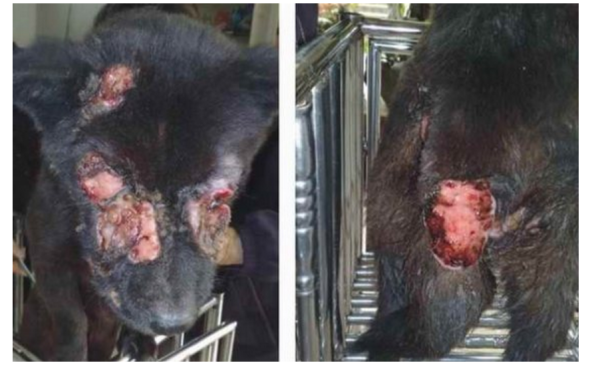Is euthanasia a gift of love?
Is euthanasia a gift of love?
Back in December 2012 I witnessed the harrowing suffering of a dog being kept alive for reasons I still cannot understand. The dog named Tidus had been viciously assaulted by child thugs and had a flammable substance flung over his delicate little body, thugs then set the dog ablaze. The injuries were some of the worst burns I myself have witnessed in years of veterinary medicine.
Tidus suffered some 75-80% third degree burns and was suffering dearly. Third degree burns in both humans and animals are the worst kind of burn injury you can sustain. A third-degree burn involves the full thickness of skin and extends into the subcutaneous fat. These burns appear charred, dry, and leathery. The hair comes out easily when pulled. Deep burns, because they destroy nerve endings, usually are not as painful as second-degree burns.
When nerve endings are destroyed either in animals or humans from third degree burns one cannot feel any pain within the effected area. Had Tidus’s life been preserved he would have had to been monitored round the clock twenty four seven to reduce any risk of him harming himself accidentally. A mere slip up and any injury sustained to the “third degree burned area” he’d neither feel any pain or be able to make his pain known to humans through crying or yelping.
Upon viewing medical online X-Rays, documents from the medical team caring for Tidus I also noted the little dog suffering from 10% second degree burns, and where skin hadn’t been torched down to the nerve endings first degree burns too mostly around the ears, nose, eyes and genitalia. Second degree burns are the most painful and can leave both humans and animals withering in pain and traumatic shock syndrome. A second-degree burn is deeper and there is blistering. If there is no infection, healing is usually complete in 21 days.
From a “professional” point of view if more than 50% of the dog’s body surface is involved with second-degree burns, or if more than 30 percent is involved with third-degree burns, survival is unlikely. So I still to this day question why a vet whom is supposedly acting professionally continued to place Tidus through further treatments, minor operations involving anesthesia down to experimental skin replacement that still today is not widely used on domestic animals with such massive skin burns.
Putting the animal under for minor operations with over 50% skin burns is dangerous too. I do question the motives of this vet, veterinary team and why this suffering animal was not euthanised compassionately. I’ve included pictures below for your information that depict Tidus under anesthesia, Tidus before any non-surgical and surgical operations were carried out and Tidus awake.
Picture (2) depicts Tidus before treatment commenced. Burned skin and hair is easily removed when third degree burns are present, the areas flesh can be seen would have caused the dog incredible amounts of pain and discomfort. Unfortunately Tidus’s treatment was in vain
Picture (3) Tidus can barely stand up and within videos online one can see he is clearly in Trauma shock which is quite typical for this type of injury. One can clearly see parts of the hind leg skeleton structure on display too - this in itself is a clear indication that Tidus had been alight for some minutes
From November to December 2012 a total sum of over $44,300USD was raised for the treatment of Tidus. Burns such as these would have required much funding for primary “veterinary care” in itself. Furthermore had Tidus’s life been preserved, secondary and tertiary care would most certainly have run into hundreds of thousands for care and medicine.
Based on the owners own financial position, the organisations responsibilities for other animals but more importantly the “survival rate” regarding second-degree burns, or more than 30 percent of third degree burns Tidus should have been humanely euthanised after a complete professional assessment was undertaken by professional vets and veterinary specialized burns teams taking all factors into consideration.
Was Tidus kept alive to prove a point, was it an act of love, or was it due to the copious amount of funding that flooded into protect Tidus? I’ll never know myself, however if I or any qualified and professional veterinary team was presented with an animal with such appalling and life threatening injuries we have to weigh the chances of survival up, financial position and community care, whilst leaving emotional feelings out.
Tidus had no chance of survival, however Tidus is one of many animals we see daily where owners will fight tooth and limb to prolong life without listening to the professional advice from those whom have treated and cared for animals for years. Unfortunately Tidus didn’t make it, weather he died peacefully or in pain we’ll never know.
Fortunately there are many loving and caring animal lovers throughout the world that go heaven and earth, spend hundreds of thousands and would do anything to save the life of their dog, cat or favorite rabbit Etc. There’s nothing wrong with this and we as veterinary officers respect such care. Compassionate and caring adults, children down to complete strangers acting unselfishly we admire. However as much as we love an animal this very love can seriously hinder or even lead to animal abuse occurring if such cases of animal mistreatment are not properly managed by veterinary teams. In Tidus’s case and being frank the vet was only prolonging life whilst the little dog was suffering. That is abuse. We wouldn’t keep a human alive that’s been seriously injured who’s chances of survival are nil, so why an animal?
Making the Call: Euthanasia
I’ve witnessed in many veterinary practices men, women and children emotionally distraught at the sheer thought of knowing their companion animal may have to be humanly euthanasied. Its a very tough decision for the best of pet owners to make however their decision is quite understandable. Pet owners have grown use to their loving companions needs and socialization, their wittiness, in a way they are not really seen as a pet, more another human like species. Making the call is quite difficult however we all have to take into consideration the suffering of the animal and work quickly to reduce any needles suffering, cost and after care Etc.
Veterinary officers also have to take into consideration care, can the owner whom for example may too have medical conditions themselves, has work commitments, or lives by oneself with little monetary income actually cope with the care of looking after a seriously ill, injured or neglected animal?
Do the owners have insurance, can an animal charity help? In some cases charities can help. In Tidus’s case he had a 501 (c) 3 helping however to what extent I still question. Tidus was in my own eyes was used as a mere pawn to garner as much funding as possible, much if not all of that funding didn’t even go towards Tidus’s care. In fact I do believe around $3000 out of the $44,000 raised for care went into helping.
Some examples below are indicators that your pet dog or cat Etc are suffering of which is the time to consider humane euthanasia or to take your companion animal to the vet for a re-evaluation.
Chronic - Non-treatable
- He/she is experiencing chronic pain that cannot be controlled with medication (your veterinarian can help you determine if your pet is in pain).
- He/she has frequent vomiting or diarrhea that is causing dehydration and/or significant weight loss.
- He/she has stopped eating or will only eat if you force feed.
- He/she is incontinent to the degree that he/she frequently soils themselves.
- He/she has lost interest in all or most of his/her favorite activities, such as going for walks, playing with toys or other pets, eating treats or soliciting attention and petting from family members.
- He/she cannot stand on their own or falls down when trying to walk.
- He/she has chronic labored breathing or coughing.
Non-treatable - Injuries/symptoms/disabilities that have outweighed overall life
- He/she has suffered non-treatable burns either over 30% of their body, quality of life is way below average - prolonging life would be considered abuse.
- He/she is suffering from incurable cancer Etc, treatment would only incur more suffering in any animal that is considered not fit to undergo any further treatment.
- He/she has been involved in a serious road traffic crash, accident Etc, injuries sustained resulted in complete incapacity. If all four or all two legs have been incapacitated keeping the animal alive would be considered abuse.
- He/she has no use of either the front or hind legs however can still walk with the aid of disability wheels, However where such contraptions cannot be located or purchased euthanasia must be considered as a last resort.
- Where insurance is not in place and animal is going to suffer without treatment/no funding can be obtained euthanasia must be considered. Prolonging the life of any “suffering” animal where funding/grants/loans/insurance cannot be obtained the welfare of that animal must come first over the overall owners love for keeping the animal alive.
Quality of life as a whole
- Quality Of Life: looks at the overall experience of a pet’s present existence.
- Pain Assessment: looks for signs of pain and suffering.
- Insight: Looks into the companion animal’s mind, in order to find out what they want us to do.
Animal euthanasia is the act of humanely putting an animal “to death” or allowing it to die as by withholding extreme medical measures. Reasons for euthanasia include incurable (and especially painful) conditions or diseases, lack of resources to continue supporting the animal, or laboratory test procedures.
Euthanasia methods are designed to cause minimal pain and distress. Euthanasia is distinct from animal slaughter and pest control, which are performed for purposes other than an act of mercy, although in some cases the procedure is the same.
In domesticated animals, this process is commonly referred to by euphemisms such as “put down”, “put to sleep”, or “put out of his/her/its misery”. Euthanasia can be as explained extremely distressing to all pet owners, however veterinary officers and vet technicians are here to explain the entire procedure, why euthanasia has been considered too. The vet and technicians will go into as much detail as possible, detailing from start to finish why they have come to their decision.
Explanations into the pets medical condition will be discussed too. The vet will allow you if the animal is not in serious pain to think about the decision made. Lastly you also have the right to a second opinion however it must be noted that if the animal[s] chances of survival are only minutes or hours it would be deemed as irresponsible for the owner to then remove the animal[s] for a second opinion of which would only increase suffering and pain greatly. At the end of the day the vets decision must be seen as the final one.
As emotional and upsetting it is to make the final call as long as the “vet has proven to you that nothing more can be done” or has shown to you “every avenue of preserving life has been exhausted within the vets hands” then the vet must be allowed to go ahead with his or her humane procedure. Vets must not be victim of a verbal or physical assault, and must carry out their jobs accordingly within the practice of good veterinary medicine, code and ethics.
Below I have highlighted two major problems that vets face within the pet medical world.
Disabilities: The problems.
Three years ago my parents sadly made the call to have their beloved pet Spaniel humanely euthanised. Zelda was quite an old dog, had enjoyed life to the full. Unfortunately one day she tried to stand up, tumbling to her legs she yelped in agonizing pain. Zelda was suffering from temporary paraplegia of the hind legs. Zelda was taken to the veterinary surgeon of which steroid injections, antibiotics and a course of massage were given.
The paraplegia was only temporary however Zelda began to suffer more and more. Gradually paraplegia went from temporary to permanent paraplegia. Zelda lost control of her bladder and sadly the vets were unable to preserve little Zelda’s life. Had the veterinary team been able to provide doggy wheels Zelda may still be with us today. Even then with both parents working doctors who’d care for Zelda? Regrettably there was none else to care for Zelda, placing her into to a foster home would have induced depression as she loved both parents dearly. Neighbors couldn’t help either as the nearest neighbor was oven ten kilometers away and was elderly.
Over the years I’ve read numerous comments from members of the public on Facebook that see a very sick, diseased and dying animal of which they demand the owner does everything they can to ensure the pet dog, cat Etc is saved from death. Some people believe that life is sacred and will not take a life even if the animal is in misery for example paralyzed from the neck down or a multiple amputee. They judge animal life by human standards and insist on a natural death, however miserable the quality of life. Animals are not human and must never be classed as the same.
They consider that ending a life for any reason other than to eat, is the right of god alone. Most religions depict a god (or gods) who has trusted humans to take wise decisions. Where euthanasia is concerned, the challenge may be for the owner to be an instrument of their god and choose euthanasia to prevent further suffering. For example in the Judaeo-Christian belief system, God gave man stewardship over the animals - refusal to make a humane decision is a prime example of passing the buck!
Veterinary officers do have quite a tough job on their hands when all avenues have been exhausted to help prolong life of any animal. For example in many countries pet wheels (as seen above) are not provided by all veterinary practitioners. In fact I do not know of any vet that I have met or are friends with that have such disability contraptions at their disposal to freely hand out or sell.
Furthermore we must all remember that dogs, cats even horses Etc are not all equal. Where human doctors can freely hand out wheel chairs (E.g) of which require very little tuning, in the case of dogs and cats this is more easier said than done. Vets in many countries do not have the resources, man power, funds or even the access to disabled equipment. As many vets do not have such disabled equipment within their clinic they then have to weigh up the quality of life of their pet patient, bearing in mind too can the owner physically cope with looking after a non-walking animal, cope with the strains of incontinence, exercise Etc. In Zelda’s case both parents could not give their fourteen hour day jobs up, and didn’t have information on where to locate pet wheel chairs.
When viewing such comments from mainly online Activists demanding that the owner[s] not humanely euthanise sometimes I feel like shaking some sense into them. Its not just the pet owners that have to make decisions here its also the veterinary team and the limitations, obstacles and overall care the vet has to decide on.
When do we call euthanasia?
Even in today’s modern world there are more sick repulsive individuals then there was over three decades ago whom abuse and harm animals. Three out of every ten animals I see within my own private medical practice have been seriously abused or neglected by children. Dogs or cats set on fire, horses cut with knifes, or in Xixi’s case children gouged Xixi’s eyes out and cut his genitals off back in 2010.
Xixi was viciously assaulted in Guangdong province, China and while many of you may think such cases are seen only in China you are very wrong, throughout the world there are many selfish, twisted and sick people that go even further to fulfill their deprived desires to abuse an animal.
The report reads:
Child animal abusers cut both eyes, even his genitals were cut off, and his body was covered with holes. Yet Xixi still tenaciously supported his own hurt body, roaming around the neighborhood. The surrounding people did not dare approach him, because Xixi’s appearance was very frightening. Only until a volunteer appeared was Xixi rescued. According to the rescue group, when Xixi was being taken for medical treatment, he desperately bit at the rope that tied him, because Xixi was afraid of being hurt again.
Picture below depicts a savage act of animal abuse by children.
This alone is enough to prove how strong Xixi’s will to live is. However, according to several doctors’ diagnosis, Xixi first suffered external injuries all over his body from human abuse, and then because of not being immediately treated, his wounds became infected and he developed leukemia, causing white blood tumors to form in his body, however since the attack Xixi’s wounds began to quickly fester, his situation was serious and unable to be controlled.
After careful observation by volunteers over a day and a night, it was very exerting and painful for Xixi to urinate and defecate, leading to a part of his intestines to be expelled. Apart from that, Xixi kept going to dark corners. Those who have raised pets and have some experience all know that this is what dogs (and other animals) do when they know they are about to die and want to find a peaceful place to leave the world, and eventually Xixi chose to leave…
End of Report…. 2010.
Every single day we are presented with yet another case of serious animal abuse, and everyday we are challenged on how best to proceed with these cases, is it in the best interests of (any animal) to continue any such medical treatment or is it in the interests of the screaming, shouting and pressuring individuals online? Furthermore will medical treatment help or just increase further pain, discomfort and suffering? While many animal Activists online scream at us all to do something they do at the very best of times fail to see that animals are in a way no different to humans when it boils down to actually “saving” life.
Had Xixi or Tidus been presented to myself and based on the injuries, prognosis, underlying medical condition’s, primary suffering, mental stability Etc both animals would have been there and then after all reports had been completed humanly put to sleep. Both animals would have been put to sleep only after reports concluded injuries, pain, mental state and suffering outweighed both present and future life.
Cost, care, rehabilitation and “would the owner or career be able to continue with such care would also have been taken into consideration, the type of care too. I.e specialized burns, in Tidus’s case he would have required specialist treatment, after care and would have to have been virtually wrapped into a bubble to protect his third and second degree burned and damaged skin.
Xixi’s case though is not identical to Tidus’s case. Tidus was kept alive despite the fact his injuries heavily outweighed his chances of survival. Volunteers that done their very best for Xixi and within a country where medical services are limited worked their hardest to save this little dog. However sadly Xixi like Tidus eventually succumbed to death.
In cases where abuse and neglect are at there very worst veterinarians are challenged greatly. Putting animals to sleep is not one of the hardest parts of being a veterinarian. That’s because euthanasia is often a blessing and gift to a suffering animal. In most vets experience, the hardest part of being a veterinarian is telling owners that their beloved pet has a terminal illness and will soon be leaving this world. The emotions that pass across their faces, even if they have suspected the worst for some time, are heart-wrenching.
Below is a quality of life assessment that you can use yourself to asses your animal and whether its the best time to now take your loved one for medical attention or just a friendly chat. Many characteristics are not, by themselves, an indication for euthanasia. For example, stiffness and reduced interest in play have small numerical values. Adding the smaller values together may generate a score which is high enough to indicate the time has come to euthanize, or the score may only indicate that the pet should be re-evaluated periodically. Vets will only put an animal to sleep after every avenue has been exhausted, however it must be noted in serious cases of abuse putting an animal to sleep quickly to reduce further physiological and mental suffering must be paramount.
The Pain Assessment allows the human companion to estimate the amount of pain which a pet is experiencing. Unfortunately animals do not speak in human languages, so they cannot tell us in our language what amount of pain they are experiencing. As a result, the human companion must look for behavioral signs which are then interpreted as indicators of pain. When veterinarians are presented with severe cases though such as that of Tidus or Xixi the call has to be made much faster to reduce further suffering. Unfortunately for Tidus his pain and suffering continued.
Since 2012 I have been researching more and more cases that are either identical to Tidus or worse. Within the majority of cases I have viewed veterinarians taking the relevant actions where and when needed, consulting with the pet owner, and acting completely professional. Unfortunately I have also witnessed cases even worse than Tidus and Xixi’s where veterinarians are being pounded daily by online Activists or individuals in general that seem to force them into prolonging life.
This behavior is grossly unprofessional and if I myself continue to witness it I will call these veterinarians to account and demand what their game actually is here. Are they trying to help the animal or are they merely looking for fame, are they in it for the money or are they acting competitively to prove a point?
Animal abuse is a crime and not something I or my team take sitting down, there are all forms of abuse carried out by a wide range of people. Keeping “any” animal alive just to increase a Facebook page’s likes is considered abuse, to increase monetary income - its abuse, seeking fame and glory - abuse, for ones own egodriven manner - ABUSE.
Is euthanasia a gift of love? Yes euthanasia is very best gift of love when an animal cannot any longer be saved or where treatment has failed. Leaving an animal to suffer while promoting to millions failing medical treatment is neither professional nor acceptable.
Dr Jose C. Depre
INTERNATIONAL ANIMAL RESCUE FOUNDATION Inc

